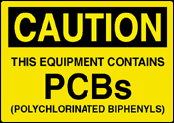



Context - Polychlorinated biphenyls (PCBs) are a group of man-made compounds that were widely used in the past, mainly in electrical equipment, but which were banned at the end of the 1970s in many countries because of environmental concerns.
Because these compounds are generally very stable, they remain present in the environment today.
What are the health risks associated with PCBs?
This Digest is a faithful summary of the leading scientific consensus report produced in 2003 by the International Programme on Chemical Safety (IPCS) of the World Health Organization (WHO): "Polychlorinated biphenyls : Human health aspects. Concise international chemical assessment document 55![]()

Source: US federal Government
Polychlorinated biphenyls, in short PCBs, are a group of man-made chemicals.
1.1 PCBs have been used in many different products, including electrical equipment, surface coatings, inks, adhesives, flame-retardants, and paints. PCBs may be released into the environment, for instance when waste that contains PCBs is incinerated or stored in landfills. About 10% of the PCBs produced since 1929 still remain in the environment today. Because of possible impacts on human health and the environment, the use and production of PCBs are now banned or severely restricted in many countries. More...
1.2 All PCBs are man-made and have a similar basic structure. They are made of carbon, hydrogen and chlorine atoms. Because these atoms can be combined in many different ways, a total of 209 different PCB molecules can be formed. Some PCBs are more harmful than others.
Generally, PCBs are very stable which explains their persistence in the environment. At high temperatures, PCBs can burn and generate dangerous by-products such as dioxins. PCBs tend not to evaporate or to dissolve easily in water. However, they are very soluble in fat and similar substances, which explains why PCBs can build up in animal fat and along the food chain. More...
2.1 In rivers and lakes, PCBs attach to sediments where they can remain buried for a long time before being eventually released into water and air. PCBs in the air can reach the ground with falling rain and snow, or simply when suspended particles settle with gravity. More...
2.2 PCBs can build up in animals over time and along the food chain. PCBs are found in the fatty tissues of animals living in water or on land, particularly those at the top of the food chain. Thus humans can also accumulate PCBs from the food they eat. Some animal species, including insects and other invertebrates, birds, fish, and mammals, can break down or transform certain PCBs within their bodies. More...
2.3 In air, PCBs are broken down by the indirect effect of sunlight. Depending on the specific type of PCB, it takes from a few days to several months for half the amount initially present to be degraded. In water, breakdown of PCBs is slower, and can occur under the action of sunlight or microorganisms. These organisms play an important role in the breakdown of PCBs in soils and sediment. More...
2.4 Outdoors, PCB levels in air were found to be lower in rural and remote areas than in urban and industrial areas. In indoor air, concentrations of PCBs are typically at least ten times higher than in outdoor air.
PCB levels in sea water tend to be highest in waters near industrial areas. Since the 1970s, when restrictions were imposed on the production of PCBs, concentrations in new deposits of river sediments and in fish have shown a gradual decrease. More...

Humans are exposed to PCBs via food, air and drinking water.
3.1 Overall, humans are mainly exposed through consumption of contaminated foods, particularly meat, fish, and poultry. The dietary intake of PCBs for adults rose to a high in the late 1970s, but then decreased to a lower level by the 1990s. More...
3.2 Infants can be exposed to PCBs contained in human breast milk. As in foods, average levels in breast milk have decreased since the 1970s. More...
3.3 The general population is exposed to low levels of PCBs present in the air they breathe particularly indoors, but also outdoors. However, in PCB disposal facilities, PCB concentrations in air can be significantly higher leading to a greater exposure in workers. More...
3.4 The general population can sometimes be exposed to low levels of PCBs in drinking water, though concentrations are often too low to be measured. More...
Humans can absorb PCBs by eating or drinking contaminated food, and, to a lesser extent by breathing contaminated air or through the skin.
Once absorbed, PCBs move into cell membranes and into the blood vessels and the lymphatic system. The highest concentrations of PCBs are usually found in the liver, fatty tissue, brain, and skin. They are also present in the blood. In mothers, PCBs have been found to pass into umbilical cord blood, the placenta and breast milk.
In both humans and animals, PCBs can also be transformed into substances that accumulate in specific tissues and body fluids. They may also be transformed into other substances allowing them to be excreted through urine and feces. More...
5.1 In animals, exposure to one large dose of PCBs can cause diarrhea, breathing difficulties, dehydration, decreased response to pain, and coma. PCBs were found to mainly damage the lungs, the stomach, and the pancreas. Lower doses of PCBs administered over a period of time can interfere with liver and thyroid function, and may, in the long term, lead to liver cancer. More...
5.2 Effects on fertility, reproductive organs, and female hormonal activity have also been seen in test animals exposed for a long time to high doses of PCBs through their food.
The offspring of animals fed PCBs during pregnancy and during breast-feeding may also be affected and many have shown learning and behavioral difficulties. In the young, development of the immune system and certain organs such as the liver, thyroid and kidney have also been affected by exposure to PCBs. More...
5.3 Observed effects of PCBs on the immune system included a lesser production of antibodies, an increased susceptibility to disease, and decreased weight of the thymus gland. Adult animals appear to be less sensitive than the fetus to the effects of PCBs. More...
5.4 PCBs with different chemicals structures behave in different ways. Certain PCBs behave like dioxins and may cause an increased risk of cancer. Others can affect the development of the nervous system at high exposures. More...

It is difficult to determine to what extent PCB exposure affects human health, because different people are exposed to different amounts and mixtures of PCBs, and because they may also be exposed to other toxic substance at the same time. More...
6.1 Many studies suggest that there is a link between exposure to PCBs and increased risk of cancers of the digestive system, the liver, and of the skin. Furthermore, high levels of PCBs in the blood may be linked to a cancer of the lymphatic system. More...
6.2 PCB exposure may affect human reproduction and may be linked to reduced fertility in women and a lower mobile-sperm count in men. Exposure during pregnancy and breast feeding may be linked to slowed infant growth and development. More...
6.3 PCB exposure may also be linked to neurological health effects, (such as numbness and headaches), more frequent infections, and changes of the skin, particularly rashes and chloracne. More...
Current understanding about the effects of PCB exposure on human health is mainly based on findings from animal studies using mixtures of PCBs. More...
7.1 Studies revealed at what daily dose of PCBs a sensitive species of monkeys started showing signs of negative health effects (on the immune and nervous system). More...
7.2 Based on these experimental findings a tolerable daily intake of PCBs has been established for humans. More...
7.3 In the USA for instance, it is estimated that people are exposed to 1 000 times less PCBs than the minimum intake causing adverse effects in animals, and four times less than the tolerable daily intake. More...
7.4 Establishing a Tolerable Daily Intake based on studies on animals entails uncertainties. On the one hand, monkeys may be more sensitive to PCBs than humans. In this case the predicted tolerable intake would be too prudent. On the other hand, specific PCBs to which humans are exposed may be more or less toxic than the PCB mixtures used for the studies on monkeys. More...

PCBs are a group of man-made chemicals that have been used in a variety of manufactured goods since 1929. PCBs can tend to persist in the environment and accumulate in the food chain. Many countries have banned or severely restricted the production of PCBs.
Humans may be exposed to PCBs by consuming contaminated food, and also by drinking contaminated water and breathing contaminated air. Mothers exposed to PCBs may transmit them to their child. The speed at which PCBs are transformed in the body and the extent to which they are either stored or excreted vary according to the type of PCB.
Depending on the dose, the type of PCBs, and other factors, exposure to PCBs can affect fertility, child development, the immune system, and possibly increase the risk of certain cancers. More...

This summary is free and ad-free, as is all of our content. You can help us remain free and independant as well as to develop new ways to communicate science by becoming a Patron!